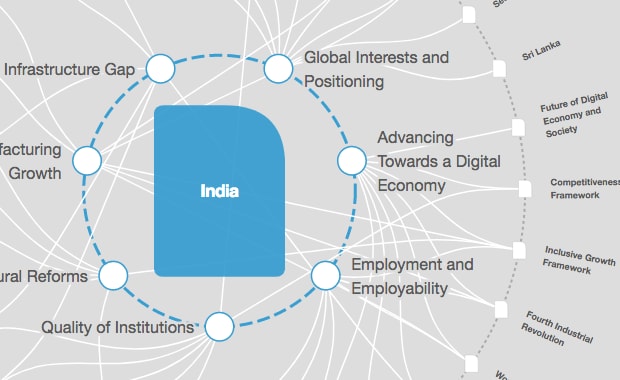Is this the key to unlocking India's huge tourism potential?

Image: REUTERS/Fayaz Kabli
India's culture and diversity make it a land of unlimited opportunities. Each city and state has so much to offer in terms of the heritage, architecture and experience that can be explored. India's tourism potential is huge.
In 2016, India was visited by 9 million tourists. When looked at in isolation, that seems a large number - but when compared with, say, the city of Barcelona, which received 8 million tourists last year, one begins to wonder why a country with 29 states and 4,000 cities managed to attract so few foreign travellers.
The World Travel & Tourism Council calculated that travel and tourism directly and indirectly generated $208 billion, or 9.6% of India’s GDP, in 2016, and supported over 40 million jobs, 9.3% of the country's total employment. The tourism sector is predicted to grow at an annual rate of 6.7% to $420 billion by 2027 (around 10% of GDP).
However, there exists the potential to increase this growth rate to 30% - and when that happens tourism will contribute around 25% of our GDP.
The secret to enabling this growth is hidden in India's 600,000 villages, which together represent an ocean of heritage, culture and experiences waiting to be explored. Yet to unlock the hidden potential of India's villages, we need to approach the issue through the lens of impact tourism.
Impact tourism
Impact tourism is a community and tourist-centred approach in which tourism is leveraged to help deliver sustainable community infrastructure. It gives tourists an authentic experience of local culture and traditions while helping the community - and both these objectives are aligned with the evolving targets of the Paris Agreement and the UN's Sustainable Development Goals. Impact tourism leads to sustainable rural development and provides livelihood opportunities for rural communities. It is a win-win situation for all stakeholders. Its potential is immense.
The average global tourist is now looking for experiences and a story rather than just a point and shoot-tour. More people go to Barcelona than India because the Spanish city has stories to share and experiences to offer that are lacking back home. Technology, especially through social media, has created an environment in which millennials are becoming inspired to imagine and develop their own personal travel experiences. It's not about going on a trek in Machu Picchu; it is the conversations with local communities that are inspiring people to take up such experiences, and to understand our world in a new way. We want to be inspired by the places we visit and the people we meet, and this is paving the way for experiential tourism.
The village-based impact tourism model can boost tourism by $25 billion by bringing 15 million extra tourists to villages alone, creating 100,000 village-level entrepreneurs in the process. Local state governments should work hand-in-hand with social organisations to identify key development issues in their villages, and then use the impact tourism model to help develop these communities while promoting them as tourist destinations. This would achieve two objectives at once: giving tourists an experience and memories to last for a lifetime, while providing villagers with opportunities to improve their livelihoods.
If done correctly, this approach could exponentially increase the numbers of tourists visiting India, while at the same time incentivise villagers to stay in their villages rather than add to the growing migration away from rural areas to the cities.
Tourists could experience living with villagers in Rajasthan, for example. They could learn about traditional Rajasthani culture and traditions, while giving back to the community by installing a water filter in the home in which they are staying, for example, or painting village homes. Or it could be something as simple as engaging villagers in literacy sessions on themes that can be decided on by heads of the local community based on the needs of their villages. This model also helps to revive traditional art forms by giving the villagers a direct market place to sell their local produce as souvenirs to the tourists visiting them.
The problem and the solution are very straightforward; what is needed now is an effective partnership between the government and the private sector. A national tourism board will be able to provide the tourism sectors with a voice at government level. Currently the Indian tourism industry is self-governed by multiple agencies with no common goals. A tourism board, however, could clearly define the roles and responsibilities of both the government and private sector. It could align stakeholders with common goals and a common vision - which could be, for example, 'increase tourism's contribution to GDP to 30% by 2023'.
The private sector can develop experiences and impact tours using the infrastructure provided by the government such as airports, roads and rail connectivity to the remote areas of India. In this model, everyone is a winner, including the local communities that will benefit immensely from the tourism. All it needs is for all stakeholders to open their minds to India's untapped tourism potential, and to develop a clear plan of execution. Otherwise this is in danger of becoming a gold mine that we never explore.
Don't miss any update on this topic
Create a free account and access your personalized content collection with our latest publications and analyses.
License and Republishing
World Economic Forum articles may be republished in accordance with the Creative Commons Attribution-NonCommercial-NoDerivatives 4.0 International Public License, and in accordance with our Terms of Use.
The views expressed in this article are those of the author alone and not the World Economic Forum.
Stay up to date:
India
The Agenda Weekly
A weekly update of the most important issues driving the global agenda
You can unsubscribe at any time using the link in our emails. For more details, review our privacy policy.
More on Geographies in DepthSee all
Spencer Feingold
November 20, 2024







